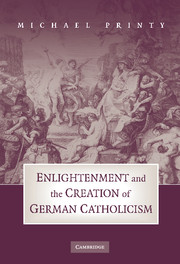Book contents
- Frontmatter
- Contents
- Acknowledgments
- 1 Introduction
- Part One PERFECT SOCIETIES: RETHINKING THE CHURCH AND THE STATE
- Part Two THE UNIVERSAL CHURCH AND THE UNIVERSAL CLASS
- 6 Catholic Enlightenment and the Search for a Bourgeois Catholicism
- 7 A Program for Reform
- 8 Pastors of Enlightenment: Reforming the Secular Clergy
- 9 Gallican Longings: Nation and Religion in the German Enlightenment
- 10 Conclusion
- Bibliography
- Index
7 - A Program for Reform
Published online by Cambridge University Press: 02 July 2009
- Frontmatter
- Contents
- Acknowledgments
- 1 Introduction
- Part One PERFECT SOCIETIES: RETHINKING THE CHURCH AND THE STATE
- Part Two THE UNIVERSAL CHURCH AND THE UNIVERSAL CLASS
- 6 Catholic Enlightenment and the Search for a Bourgeois Catholicism
- 7 A Program for Reform
- 8 Pastors of Enlightenment: Reforming the Secular Clergy
- 9 Gallican Longings: Nation and Religion in the German Enlightenment
- 10 Conclusion
- Bibliography
- Index
Summary
THE CHURCH AND THE PUBLIC
In rethinking the church, educated German Catholics “scrutinize[ed] the signs of the times” and imagined a Catholicism that, they felt, would do away with outworn accretion and would be suited to the world in which they lived. While the diversity of visions prevents a monolithic account, a sample of the pamphlet literature can at least lend insight into the shape of the religious world of German Catholic Enlightenment thinkers. This pamphlet literature constituted a Catholic subculture of the public sphere, and reflected the conditions of the literary world of Publizistik, the typically German discourse on public affairs. The educated German Catholics who participated in this forum considered the church in some form to be subject to public discussion and debate. This was a specifically German Catholic public sphere, but it was not hermetically sealed from the influence of Protestant German vernacular works. Benedikt Werkmeister, for one, contended that the Enlightenment was spread in Catholic parts of Germany through contact with Protestants. This contact was made possible by the spread of Freemasonry among the Catholic laity and the reading of Protestant literature, particularly the works of C. F. Gellert (1715–1769) and J. G. H. Feder (1740–1821). Furthermore, Werkmeister noted, the alliance of the houses of Saxony and Bavaria during the Seven Years' War, and especially the Saxon presence in Munich during the war, introduced Catholics to new ideas:
I can still remember how the party of bigots complained bitterly about the decline of religion in Bavaria, and they blamed the Saxons for an entirely new and unheard of freedom of thought. Soon thereafter followed the establishment of the Bavarian Academy of Sciences.
- Type
- Chapter
- Information
- Enlightenment and the Creation of German Catholicism , pp. 144 - 165Publisher: Cambridge University PressPrint publication year: 2009

